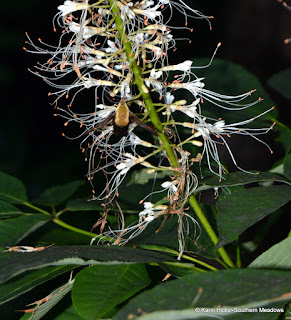Wildflower Wednesday: Bottlebrush Buckeye
The Aesculus parviflora shrub adorns long wands that resemble a bottle brush and are one of my favorite flowers of summer. Our oldest shrub grows in a semi shaded area near the path that runs along the side of the house, where it gets a hint of midday sunshine.
 |
| Bottlebrush buckeye shrub near walking path |
 |
| Flower wands attract native pollinators |
I'm not the only one who loves this plant. Pollinators dance through the long wands known as panicles.
Butterflies cover the spires that bloom in late June to July.

The white tubular trumpets that house the red anthers and pink filaments are also visited by diurnal moths,
 |
| Clear wing hummingbird moth |
As a result of their pollination services, the plant grows pear shaped nuts in early autumn. The orange nuts are encased in a husk that splits open to reveal gorgeous 'buckeyes'. Squirrels and chipmunks feast on these protein rich nuts. They don't last long in our garden.
 |
| Buckeyes: orange nuts |
 |
| golden foliage in fall |




.png)
